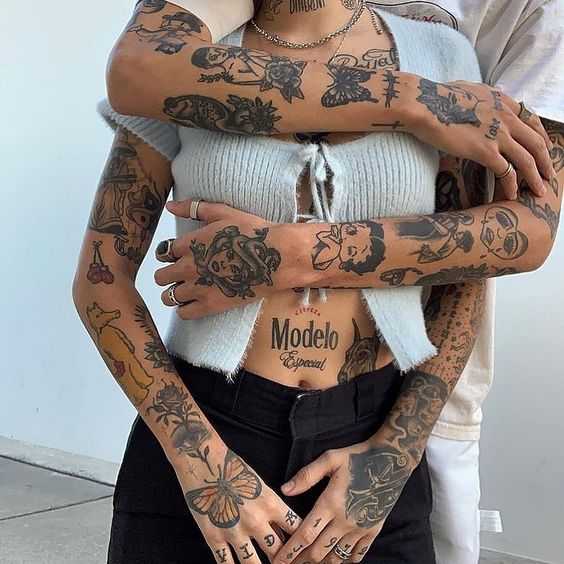Slow down. Put down that Pinterest photo. There are some things you need to think about before spontaneously getting that inexpensive flash tattoo from the first tattoo shop on your Google results.
You found that perfect tattoo idea. Maybe it’s meaningful to you. Maybe you just think it will look cool! It’s your body and your money, so don’t let anyone — even VALLEY — tell you what to do and what not to do with your tattoos.
However, VALLEY does have some guidelines for tattoo selection and etiquette to make the process as seamless as possible for you and your artist.
Go For Timeless
Some tattoo styles or specific designs go in and out of style like fashion trends. Try to find a design that you like for yourself, not just because your favorite influencer has one just like it. Your artist will make the tattoo 100% unique to you, so choose a design that feels authentic.
If you struggle with tattoo commitment, choosing something timeless rather than trendy can alleviate that concern.
Research different tattoo styles. Traditional, neo-traditional, fine line, blackwork, watercolor, patchwork, realism, geometric, ignorant and many more styles give artists methods to bring out a unique beauty in different designs. Pick one that will complement your idea best!
Finding an Artist
Once you find your preferred style, research tattoo shops in your area and note what style they specialize in. Entire shops can specialize in one style, or a shop may have a diverse staff with different styles.
When you find an artist, stalk their social media. Many artists use Instagram to showcase their art and attract new clients. What’s their vibe like? How do you feel about the other tattoos they’ve done? If you’re lighting up looking at their work, find out how they prefer to take client submissions. Some artists book clients through Instagram, but some might want you to call their shop or use an online form.
Tattoo artists take pride in creating unique work, so some might not want to replicate your inspiration photo line for line. Be open to their ideas and communicate your wants for this tattoo; they might create a design that you like even better than your inspiration.
Sizing
When you reach out to an artist to book an appointment with them, describe with specificity. Qualifiers like “small,” “medium” and “large” mean completely different things to each person. What you might consider to be a small tattoo could be completely different than what the artist considers “small” to mean.
Tell your artists the size that you want the tattoo in a specific measurement: inches or centimeters. It’s ok if you don’t know the exact measurement; try to estimate within a range of one or two inches. For example, you might want “a three to four-inch tattoo.”
Cost
Some artists charge hourly, and some charge by size. Tattoo shops often have a “shop minimum.” For example, a shop might require every tattoo to cost at least $100. Before booking your appointment, ask your artist how much they estimate your tattoo will cost, how much they charge to reserve your appointment and how much their shop minimum is (if applicable).
Communicate your budget for that specific tattoo; be sure that you agree on a price to avoid an unpleasant surprise when the time to pay arrives.
Placement
Tattooing different parts of the body provides different experiences for you and the artist. Tattoo placements on sensitive areas where skin tends to sit closer to the bone such as ribs, backs of hands and feet, knees or elbows can cause the client more pain. Therefore, creating a challenge for the artist.
If you have a placement in mind, tell your artist before the appointment, especially if it’s a challenging placement. However, if you don’t know where you want to put the tattoo, your artist can try out your stencil in different places.
No Pain, No Gain
There’s no way around it: tattoos hurt. Based on pain tolerance, everyone experiences tattoos differently. Some people describe a tattoo needle as a light scratching, even finding the process relaxing. Other people struggle more with the pain.
If you feel nervous about experiencing strong pain during your tattoo, set yourself up for success. Stay away from drugs and alcohol a full day and night before your appointment. Eat a hearty meal before your appointment with protein, carbs and fats, and hydrate yourself. Some tattoo shops sell lidocaine numbing cream to apply before the tattoo, but you can also buy lidocaine cream from the drugstore.
Getting tattooed can lower your blood sugar. If you’re scheduled for a long appointment, bring a granola bar or a cookie. Your artist will understand if you need to take a break for a snack or drink of water.
Always communicate how you feel during the process. You can ask your artist to chat with you to distract your mind, or you can tell them that you prefer a silent appointment.
Healing
You did it! Your tattoo looks awesome! Your artist might put a clear bandage over it to keep on it for a few days or some plastic wrap to keep on it just for the first day.
Ask your artist how they prefer their clients care for a new tattoo for specific instructions. However, a general rule of thumb: keep the skin clean and hydrated. Avoid swimming pools, hot tubs and the beach. Clean the tattoo once or twice per day with a gentle, unscented, anti-bacterial soap and apply an unscented hydrator like Aquaphor. A new tattoo scabbing or feeling itchy is perfectly normal, but try not to scratch or pick at it. Always keep a new tattoo out of the sun. After a few weeks of healing when the skin no longer feels raised, apply sunscreen regularly to the area to prevent early fading.
Follow @VALLEYmag on Instagram for more beauty and health advice!





